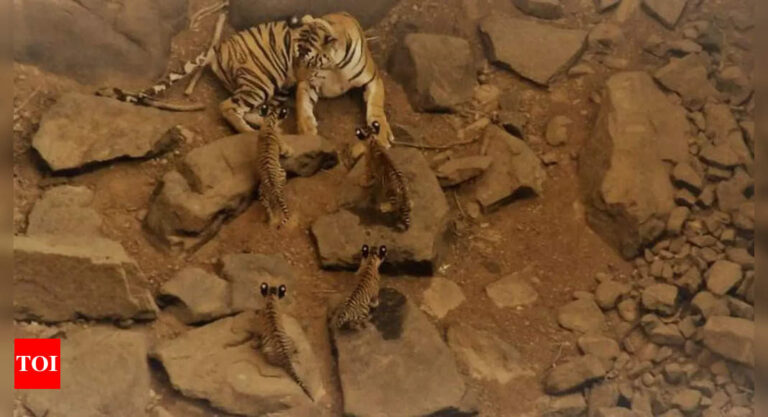
Devoid of tiger population that fell to poaching and other reasons, Panna became a model in tiger reintroduction project with a population of 80 big cats (cubs and sub adults) and T1 contributed to this remarkable success story delivering 13 cubs in five litters, including four in her last litter in 2016.
From the dark depths, Panna made a complete turnaround.
Official release by the park authorities says that the death was natural.
Her defunct radio collar was found near the carcass.
Samples were collected for forensic examinations and the remains were disposed of in compliance with NTCA guidelines.
In 2009 it was found that Panna didn’t have even a single tiger left from 20 three years earlier.
A decision of relocating two tigers and two tigresses to the park was taken in June 2009 by the ministry of environment and forest and task of relocating tigers was initiated by R Shreenivasa Murthy, the then field director of Panna National Park.
“Came to know T1 of Panna Reintroduction (First tigress from Bandhavgarh reintroduced at Panna) passed away. What a magnanimous gentle lady. Very peaceful and coolest of the tigresses I had witnessed. When her daughters grew up, she shared her territory with them and moved to the periphery where she lived her last phase of life gracefully. Earlier, she shared her territory with T4 also. She was one who brought happiness when the Team Panna and MP Forest department were in despair. Her role in repopulating Panna shall be always remembered. My tributes to her,” R Shreenivasa Murthy told TOI.
TI was shifted from Bandhavgarh on March 4, 2009 along with another tigress T2 from Kanha National Park and male tiger T3 – from Pench tiger reserve.
In November 2009, the male tiger (T3) strayed out of the park and started walking towards his home in Pench.
He moved continuously through the human dominating area without causing any conflict.
For over a month, the tiger was tracked by the staff of the forest department.
He was finally brought back to Panna Tiger Reserve in December 2009.
With time, he started adjusting in the habitat of Panna and acquired a territory and even started mating.
Thereafter a comprehensive tiger reintroduction project was conceived in technical collaboration with Wildlife Institute of India and the National Tiger Conservation Authority (NTCA).
The Panna tiger reintroduction project envisaged reintroducing six tigers in all including the earlier two females as a part of the founder population to start with (two males and four females).
Accordingly male tiger from Pench (T3) was brought in the month of November 2009 which after staying for a short while moved out of the park.
Some say that it was for the first time that a ‘homing’ instinct was observed in a wild tiger.
T3 was always moving in the southern direction that was his home, where Pench was located.
It travelled more than 450 km during that month-long outing.
Once he was reintroduced in the park for the second time there was no looking back.
He met and mated with both T1 and T2 and both littered in no time, the officer recalls.
T1 gave birth to four cubs in the mid-April 2010 bringing smiles on every tiger conservationist while T2 also gave birth to four more cubs in the month of October 2010.
From zero tigers in Panna tiger reserve, the reintroduced four tigresses have given birth to 17 cubs in less than three years.
Of these two cubs and a sub-adult tiger died while another cub was abandoned.
The population of tigers in PTR had increased to 18 in a small span with 5 adults and 13 cubs and sub-adult tigers.
With T4 (orphaned and hand reared tigress from Kanha) altogether a new chapter in tiger conservation history was created at Panna.
T4 was an orphaned tiger cub of just 15 days old along with two other siblings when her mother was killed at Kanha.
The park officials picked up litter of the three cubs of this mother and hand reared them with a plan to reintroduce them into the wild.
T4 was first among them to be picked up for this task and Panna was selected to experiment this new window of tiger conservation.
T4 was reintroduced at Panna reserve in the month of March 2011.
It struggled in the initial months and T3 helped her to learn hunting in the wild and her rewilding process.
The T4 later delivered two cubs in mid November 2011.
Subsequently T5 (sibling of T4) was also released at Panna in the month of September 2011.
T1 and T2 delivered their second litters in 2012 with four and three cubs respectively.
Thus, Panna is rated as the most successful tiger conservation project after a debacle.